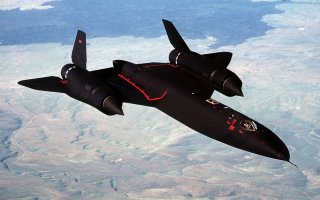SR-71 Blackbird vs. MiG-25 Foxbat: These Mach-3 Spy Planes Hunted Israeli Nukes
The most sophisticated spy planes in U.S. and Soviet service flew dangerous missions over the Middle East, supporting opposing American and Russian policies.
Here's What You Need to Know: They were both legendary planes.
In the late 1960s and early ‘70s the most sophisticated spy planes in U.S. and Soviet service—the Mach-three SR-71 Blackbird and equally speedy MiG-25 Foxbat, respectively—flew dangerous reconnaissance missions over the Middle East, supporting opposing American and Russian policies.
In June 1967 Israel went to war with Syria, Jordan, Iraq and Egypt amid mounting political tensions. According to historians Isabella Ginor and Gideon Remez, shortly before the outbreak of fighting, the Soviet Union deployed prototype versions of the new twin-engine MiG-25 to Yemen, cycling them through Egypt for secret spy flights over Israel, apparently focusing on the Jewish state’s nuclear reactor at Dimona, alleged to help produce the country’s atomic arms.
More rocket than plane, the reconnaissance version of the MiG-25 carried cameras in its nose and could sprint at three times the speed of sound at 60,000 feet or higher. At the moment of its debut, the MiG was “unmatched by anything the West could range against it,” Ginor and Remez wrote. They claim Israel tried and failed to shoot down the speedy intruders, unidentified at the time.
Ginor and Remez’s claim is not without controversy. Some skeptics doubted the Soviets would risk deploying what was then a prototype recce plane in a conflict that did not directly involve the Soviet Union.
But in 2007, the Kremlin all but confirmed the historians’ claim. Col. Aleksandr. Drobyshevsky, the chief spokesman of the Russian air force, confirmed in writing for the first time that it was Soviet pilots in prototype MiG-25s who flew the highly-provocative sorties over Israel's nuclear facility at Dimona in May 1967.
Seven years later in October 1973 the Arab armies, defeated in the first war, attacked Israel. Reeling, the Israelis put their nuclear-tipped missiles on alert. Israel’s Jericho nuclear-tipped missile "had a lot of problems with its guidance system,” a former CIA official told UPI correspondent Richard Sale, “and we weren't sure if deployment was real or just saber-rattling."
So the United States launched one of its now-legendary Lockheed SR-71s from American soil on a 10-hour round-trip mission to verify Israel’s nuclear activation. The Blackbird took off at Beale Air Force Base in California, refueled off of Rota, Spain and then flew over Syria, Jordan and Israel.
Sale claimed in his 2002 article that Israeli F-4 fighters tried to shoot down the fast-flying American plane but couldn’t match its 85,000-foot altitude.
Subsequent SR-71 flights over Syria, Lebanon, Egypt and Israel gathered intel on the fighting as Jewish forces counter-attacked with U.S. logistical support.
Jim Wilson was the pilot on one of these missions. As described in his autobiographical book, Wilson’s plane suffered an apparent malfunction. The pilot didn’t want to land in Tel Aviv. “Particularly since a conflicted Israeli government was not aware of our top-secret mission,” he wrote.
Fortunately, the malfunction was actually a false alarm.
The war itself, as the American reconnaissance, continued. The Soviet Union threatened to deploy troops to reinforce Egypt; the U.S. ramped up its nuclear posture. Rather than risk atomic war, Israel pulled back its forces.
David Axe served as Defense Editor of the National Interest. He is the author of the graphic novels War Fix, War Is Boring and Machete Squad.
This article first appeared in March 2020.
Image: U.S. Air Force photo by TSgt. Michael Haggerty

